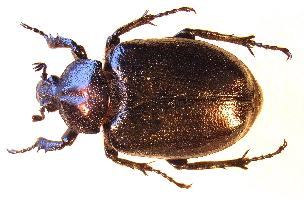
Súlyok és méretek
| Hossz | 30 mm |
|---|
Állatleírás
The Hermit beetle, scientifically known as Osmoderma barnabita, is a captivating species of scarab beetle that belongs to the family Scarabaeidae. This intriguing insect is not only notable for its ecological role but also for its unique physical characteristics and behavior.Measuring approximately 20 to 30 millimeters in length, the Hermit beetle has a robust and oval body shape. Its exoskeleton showcases a rich, velvety black color with subtle hints of a dark, rusty brown, especially around the edges of its elytra (the hardened forewings that protect the delicate flying wings beneath). The texture of its body is somewhat glossy, giving it a slightly iridescent sheen when observed under the right lighting conditions. This beetle's antennae are distinctive, featuring lamellate clubs, which means they end in small plates or leaves that can fan out or close together, a characteristic common among scarab beetiles.
The Hermit beetle's habitat is closely tied to ancient woodlands and parklands, particularly favoring environments where old, hollow trees are present. These trees provide the essential microhabitat this species requires for breeding, feeding, and sheltering. Decaying wood, especially from broad-leaved trees like oaks and willows, forms the cornerstone of the Hermit beetle's diet in its larval stage. The larvae, which are creamy white and C-shaped, undergo a long development cycle that can last between three to four years, depending on environmental conditions.
Adult Hermit beetles are primarily nocturnal and are often attracted to lights at night. During the day, they are more reclusive, spending their time within the cavities of old trees, which lends the species its common name. These cavities are not only used for shelter but also play a crucial role in the beetle's reproduction. Females lay their eggs in the decomposing wood found within these natural hollows, ensuring that the emerging larvae have immediate access to food.
The Hermit beetle, while not particularly well-known outside of entomological circles, plays a vital role in its ecosystem. By breaking down decaying wood, both the larvae and adults contribute to nutrient cycling, helping to maintain the health and biodiversity of their woodland habitats.
Despite its ecological importance, Osmoderma barnabita faces threats from habitat loss and degradation, primarily due to the removal of old trees and the general decline of ancient woodlands. This has led to concerns over the beetle's conservation status in some regions, prompting efforts to protect its natural habitat and ensure the species' survival.
In summary, the Hermit beetle (Osmoderma barnabita) is a fascinating and ecologically significant species, embodying the intricate connections within forest ecosystems. Its presence is a reminder of the importance of conserving ancient woodlands and the incredible biodiversity they support.
Új állatfotók
Top 10 állat
- Diana monkey (Cercopithecus diana)
- Dolphin gull (Leucophaeus scoresbii)
- Moustached guenon (Cercopithecus cephus)
- Galápagos tortoise (Geochelone nigra complex)
- Colossal squid (Mesonychoteuthis hamiltoni)
- Japanese spider crab (Macrocheira kaempferi)
- Stone loach (Barbatula barbatula)
- Common house mosquito (Culex pipiens)
- Common reed warbler (Acrocephalus scirpaceus)
- Sea urchins (Echinoidea)